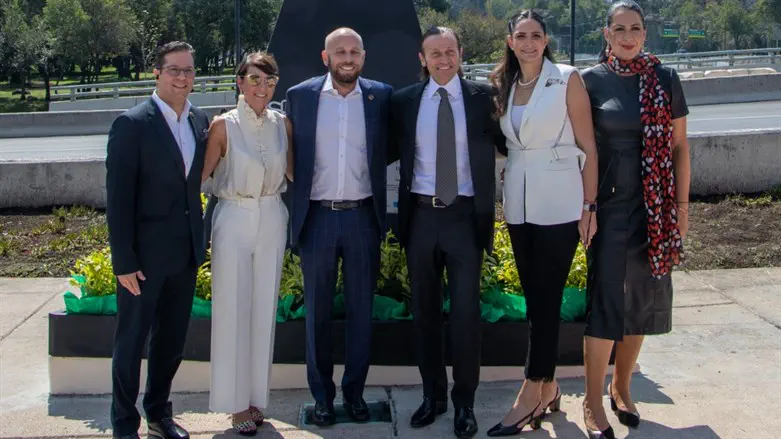
Over the last few days, the Fundacion HispanoJudia (The Hispanic Jewish Foundation) held a series of events to celebrate Hispanic-Jewish ties and shared heritage in the Mexican cities of Monterrey and Mexico City.
Led by the President of the Fundacion David Hatchwell Ataras and leaders of the Association of Friends of the Fundacion in Mexico, its President Shulamit Serur de Shrem and Director Jennie Shrem de Benabib , the Fundacion HispanoJudia instituted a Hispanic-Jewish Heritage week to increase awareness of the Hispanic-Jewish roots in Mexico, as well as to establish collaboration agreements with institutions throughout the country to further recognition of this shared heritage.
“We came here because Mexico is honest and sincere about its past and welcoming in the present and the future towards its Jewish history and ties,” Hatchwell Ataras said. “We found a great thirst amongst the leadership of this country, at the federal, municipal and academic level, to understand the Sephardic roots of the country and its people. We hope that other countries will join us and be led by this important precedent of openness towards Jewish and Hispanic ties and collaboration based on a shared ancestry.”
The Fundacion met with the Rector of UDEM (Universidad de Monterrey) to discuss collaboration on educational matters, attract students from areas around the world where the Fundacion is active and to provide scholarships for young Jewish students at one of the highest ranked universities in the world.
The Fundacion also signed an agreement with the Municipality of San Pedro Garza García, in the region of Nuevo León, where both committed to supporting efforts to research Hispanic-Jewish history and culture in the region.
The signing event was attended by Mayor of San Pedro Garza Garcia Miguel Treviño de Hoyos. The agreement takes place at a time of discovering and understanding the deep Sephardic roots of the area, demonstrated by the more than 15,000 applications for Spanish nationality by those of Sephardic descent that were processed in Mexico, the largest amount coming from this municipality.
A meeting was held with the Secretary of Tourism of Mexico Miguel Torruco, the Mayor of Taxco Mario Figueroa Mundo and by members of the Juliantla community, to lay out initial steps towards a joint collaboration for the recovery of the important Jewish heritage of Taxco, Guerrero, Mexico.
The oldest mikve (ritual Jewish bath) on the American continent is located in the community of Juliantla, which also claims to have that the oldest synagogue. Initial work is being prepared to position this town in the municipality of Taxco, Mexico in the historical and cultural context of Judaism in the Americas.
Finally, an agreement was signed between the Fundacion and the Benito Juárez Mayor's Office, with the objective of publicizing and disseminating the Hispanic-Jewish legacy of this important area of Mexico City, starting with the exhibition titled “500 years of Jewish presence in Mexico” at the Juan Rulfo Cultural Center.
This agreement was signed by Mtro. Santiago Taboada Cortina, Mayor of the Benito Juarez municipality, and Hatchwell Altaras and Serur on behalf of the Fundacion.
The goal of this agreement is to develop joint activities that will promote greater knowledge of Jewish culture in Spain and Mexico, both historic and current, to contribute to an exchange of experiences and encourage cultural participation with Jewish communities around the world, in order to make them aware of their Hispanic Jewish origins.
The Fundacion also signed an agreement with the Olami ORT school in Mexico City to promote educational supplements related to the Hispanic-Jewish heritage within the school curriculum.
As part of the visit, a sculpture titled “Viento” (Wind) made by sculptor José Sacal, was inaugurated in Mexico City, donated by the Fundación HispanoJudía and the Fundación José Sacal de México.
The sculpture was unveiled as part of the commemoration of 500 years of Jewish presence in Mexico, and of the 70th anniversary of the establishment of relations between Spain and Israel. It is dedicated to all the people who during the long colonial era were silenced by religious and governmental institutional repression. It is intended to be a recognition of those who laid the first stones on the road to freedom. The sculpture was inaugurated in the famous Paseo de la Reforma in the Mexican capital.
“This sculpture is emblematic of the rebirth of the Jewish presence in this country, representing resilience, change, fury and gentleness,” Serur said. “From the ashes a new chapter in Mexican Jewish relations in particular and Hispanic Jewish relations in general is being written, and we are so excited about all these partnerships and collaborations that are just beginning.”
